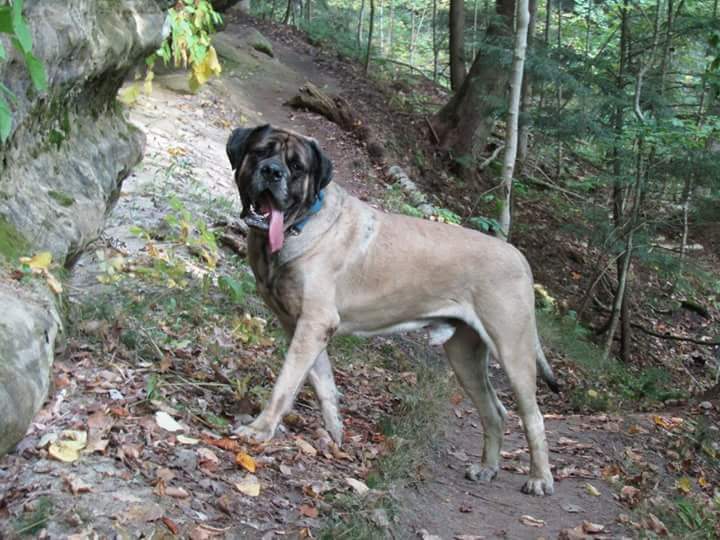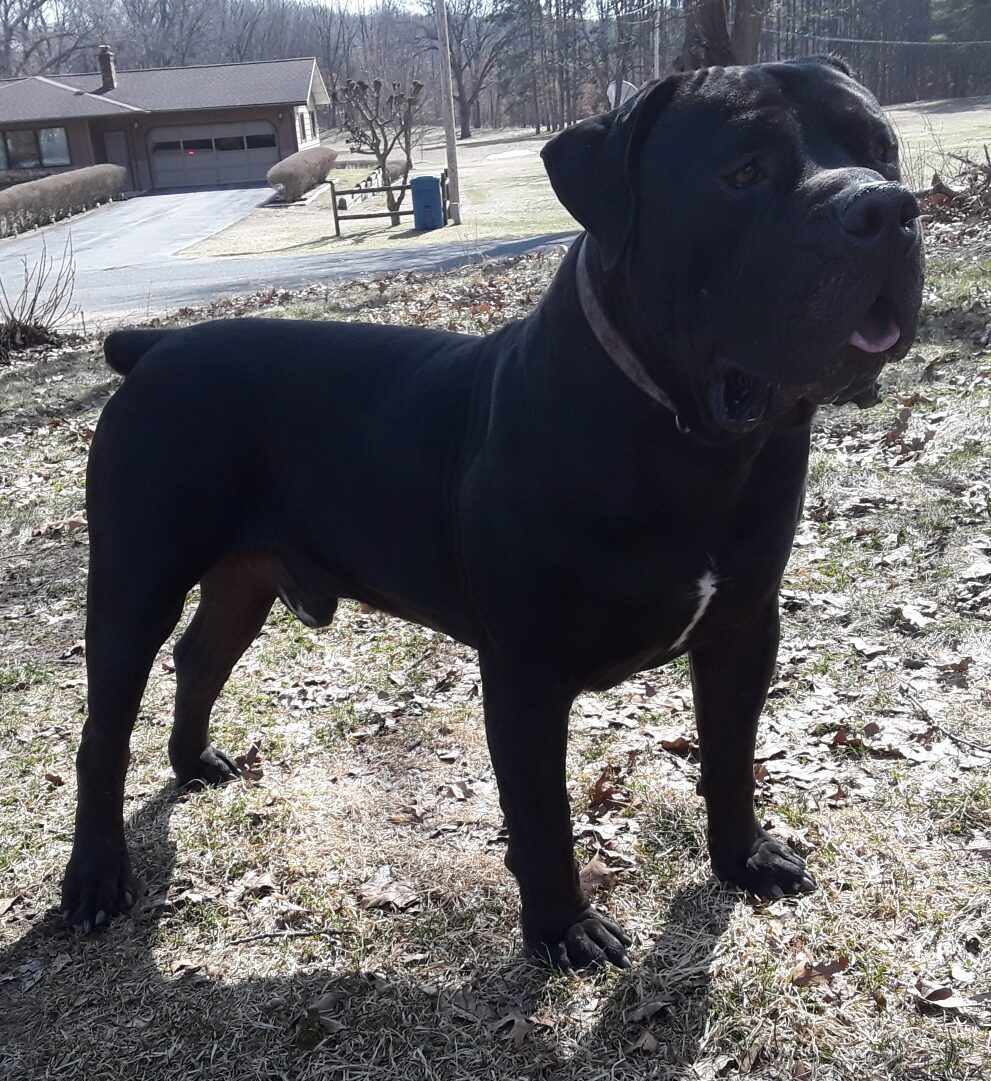
The Mastiff is one of the oldest dog breeds in existence, dating back over 2,000 years. It is properly called Mastiff (or the archaic form, Old English Mastiff), but never English Mastiff. The term English Mastiff is purely a colloquialism many people use to more easily distinguish the Mastiff (uppercase M) from other mastiffs (dogs of Molosser origin, lowercase m) and is never used in show. Males can exceed 150 lbs. in weight and females over 120 lbs. The only coat colors accepted for show are apricot, fawn, or brindle. Brindle is the dominant coat color gene; apricot and fawn are corecessive. Mastiffs were once used as fierce fighters in battle and made excellent home protectors. Today’s Mastiff is generally more docile; a loving gentle giant that will spring into action to defend its family only when absolutely necessary. Mastiffs are known more to hold intruders in place rather than attack, until their owner can take control of the situation. The Mastiff is happiest when he is within close distance to his owner and can easily monitor everything his owner is doing.
The Mastiff is a hardy, giant breed, but is prone to health problems due to its large size. Average lifespan for the Mastiff is 8-10 years, but it is not uncommon for well-cared for Mastiffs to live beyond 12 years of age. The most common health issues in Mastiffs are seasonal allergies, arthritis (especially after age 5), gastric torsion (bloat), and heart disease. In addition, it is important to keep a Mastiff puppy on a lower protein, lower calcium and phosphorus diet to ensure slower growth, so as not to cause painful panosteitis (growing pains), knuckling, and bone spurs. Mastiffs tend to be very sensitive and react poorly to negative reinforcement. They can be very stubborn, but tend to be very food-motivated and will usually respond well to positive reinforcement training with treats or praise. It is important to socialize Mastiff puppies with strangers and other dogs from a young age. It is generally safe to start socialization training when a Mastiff puppy is 16 weeks of age and has had all of its necessary puppy vaccinations. For many owners, it is also highly advisable to complete canine obedience training. An adult Mastiff can easily exceed 150 lbs. in weight and the last thing any owner wants is a massive, unruly dog that cannot be controlled. Mastiffs need minimal exercise. For most dogs this may be just a 10-20 minute walk or half hour romp in an outdoor pen. Mastiffs do not handle heat well and it is important not to overwork them, as this can put excess strain on the heart and cause a heart attack or stroke.
The Mastiff is a medium-level difficulty breed to own. The biggest challenge for a first-time Mastiff owner will be dealing with a dog of such massive size. A Mastiff’s passive nature and codependency on their owner makes them eager to please, but if not trained properly from a young age and neglected, they can be destructive and unruly. Mastiffs are often very clumsy and can easily knock things over, especially when they get the zoomies (few minute bursts of energy), and can pose a danger to small children, unintentionally. The Mastiff is not recommended for families with children under 6 years of age. For families with children, it is important to teach your children to respect the Mastiff and to never ride it, put their body weight upon it, pull its tail, or strike it. The Mastiff’s sensitive nature may cause it to snap when experiencing even a minor amount of pain, and because of their massive size, one snap can cause a significant bite. Mastiffs are generally much more tolerant of behavior exhibited by people they associate with regularly and may be aloof around strangers. It is important to allow your Mastiff to warm up to new people for a few minutes, before allowing a stranger to pet him. Beginning socialization from early puppyhood will ensure your Mastiff reacts positively more quickly to new people.
Mastiffs have a double-coat of short hair and shed throughout the year. The Mastiff should be bathed at least twice a year, but no more than once a month to keep its coat and skin in top shape. It is recommended to supplement their diet with fish or coconut oil to aid in protecting the skin and fur. Coconut oil may also be applied directly to the fur and rubbed into the skin, especially in the winter months when the atmosphere is drier. Mastiffs drool a lot, and being brachycephalic (short-muzzled) are often gassy and snorey. If these things are repulsive to you, please DO NOT buy a Mastiff. A good grain-free diet or one consisting of rice as the only grain is recommended for the Mastiff to aid in digestion and minimize the risk for gastric torsion. Many Mastiffs are also not very tolerant of chicken (fat) or beef (fat). If you find your Mastiff is itchy all the time or has excessively strong gas, try switching him to a fish, lamb, or venison-based diet. Seasonal allergies are common in Mastiffs and your Mastiff may need allergy medication, such as Benadryl, Zyrtec, or Claritin, to aid in his well-being during allergy season. If you suspect your dog is suffering from allergies, 25mg Benadryl per 25 lbs. of body weight can be safely administered to your dog 4-6 times daily, but talk with your vet about other solutions which may make things easier for you and your pet, and make your dog less drowsy.
Mastiffs are an expensive breed to own. They eat a lot of food, cost more at the vet, and tend to need more supplements to keep them healthy and at their happiest. Mastiff puppies chew a lot, so unless you want them chewing on your house, also make sure you spend plenty of money on durable toys to keep them occupied. I have found used plastic pop bottles to make awesome cheap entertainment for my mastiffs. Please consider the long-term financial burden on your family before making the decision to adopt a Mastiff. They are one of the most amazing breeds you could ever own, but that does come at a price, unfortunately. I strongly recommend either purchasing pet insurance for your Mastiff puppy or setting aside money each month into a savings account to cover expenses related to the care of your Mastiff over his lifetime.
Mastiffs typically enter puberty between 7 and 16 months of age, and may exhibit unwanted behaviors, such as marking behavior in males and menstrual behavior in females. Male marking behavior is easily correctable with quick corrections and a little patience. I have found using a leash helps substantially. If the male lifts his leg to mark on something, tug back on the leash and give a firm “NO” command and then take him immediately outside and wait until he urinates again, but giving him praise this time. Then bring him back inside and repeat this training a few times until he realizes it is never acceptable to potty inside the house or in a public building. Most males learn after 3 or 4 corrections, but the key is catching them in the act and treating it like potty-training all over again. For females, dog diapers can be purchased to aid in cleanliness during their menstrual cycle, which lasts about 3 weeks. Your bitch may exhibit changes in mood or behavior during estrus. It is almost always short-term and she will return to her normal self a couple of weeks later. Some veterinarians may tempt you into having your dog’s hormones removed (spay/castration) before your dog is old enough to exhibit these behaviors, but DO NOT neuter your Mastiff prior to 18 months of age. The health impacts can be catastrophic. Mastiffs continue to grow past 18 months of age. Some as late as 3 years of age. The sex hormones play a pivotal role in regulating the pituitary gland. The pituitary gland is responsible for telling the body when to stop growing. If this gland is not held in check, the Mastiff’s legs will continue to grow (less commonly will stunt growth) beyond what nature intended and this can lead to dysplasia of the hips and/or elbows, ligament tears (more common in females), early-onset arthritis, incontinence (more common in females), and even osteosarcoma (bone cancer). Giant breeds neutered prior to 9 months of age have about a 20% risk to develop one or more of the conditions stated above. If you choose to neuter your pet, please have a radiograph done at your vet’s office to determine that the growth plates have closed fully and that their blood panel shows no abnormalities that could cause complications during spay/castration surgery. If you are concerned with helping to control the pet population, a vet may perform an ovary-sparing spay or vasectomy as early as 6 months of age for your Mastiff. These procedures keep the sex hormones intact, but render your dog unable to reproduce. In addition, an ovary-sparing spay protects your bitch from developing pyometra later in life; one of the most common life-threatening ailments in bitches. Should you choose not to neuter your pet at all, please be a good steward and ensure your dog never has the opportunity to create an unwanted litter of puppies. There are tens of thousands of dogs in the United States that get euthanized every year in shelters because of irresponsible pet owners. Please don’t contribute to this statistic! There are many health benefits to keeping your pet intact for life, such as lowered risk for most types of cancer, obesity, diabetes, etc., but it requires you to be a diligent owner.
For more information on the Mastiff, please visit the link below: https://www.akc.org/dog-breeds/mastiff/
